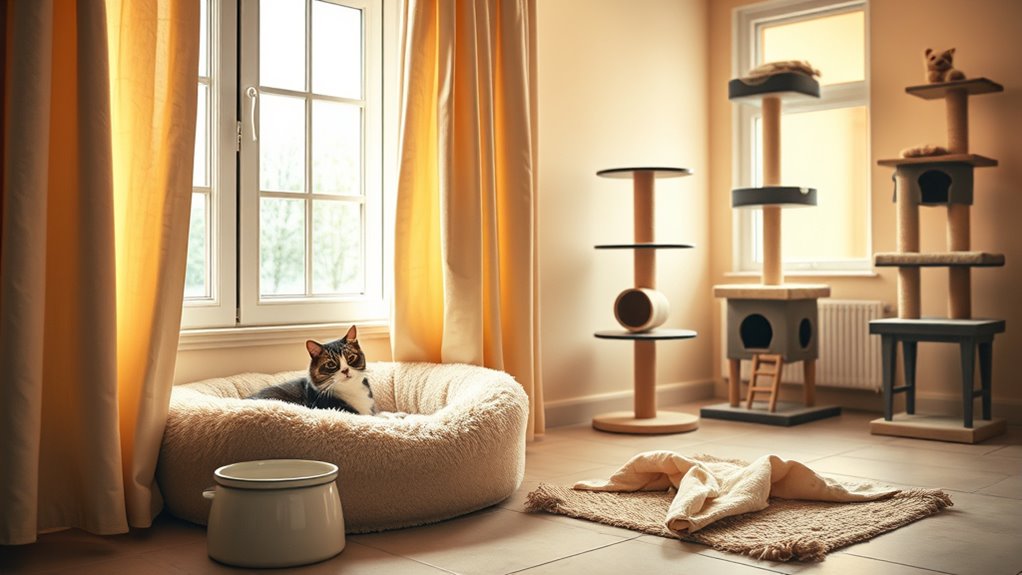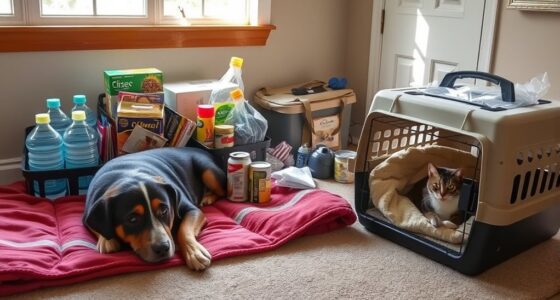To prepare your indoor space for your elderly pet before frost sets in, assess their unique needs and comfort preferences, then create a warm, cozy sleeping area with supportive bedding away from drafts. Guarantee easy access to food, water, and bathroom spots, and maintain a consistent, comfortable temperature using safe heating options. Secure entry points and keep hazards out of reach. Staying attentive to their behavior and comfort will help keep them safe and snug through colder months. Keep exploring for more essential tips.
Key Takeaways
- Assess your pet’s specific needs, health issues, and comfort preferences to create a tailored indoor environment.
- Ensure areas are warm, cozy, and accessible with supportive bedding and easy entry points.
- Place food, water, and bathroom spots on low, stable surfaces to minimize strain and prevent accidents.
- Use safe, thermostatically controlled heaters and climate control devices to maintain a consistent, comfortable temperature.
- Regularly inspect the space for hazards, secure loose items, and maintain proper ventilation for safety and health.
Assessing Your Pet’s Specific Needs and Comfort Preferences
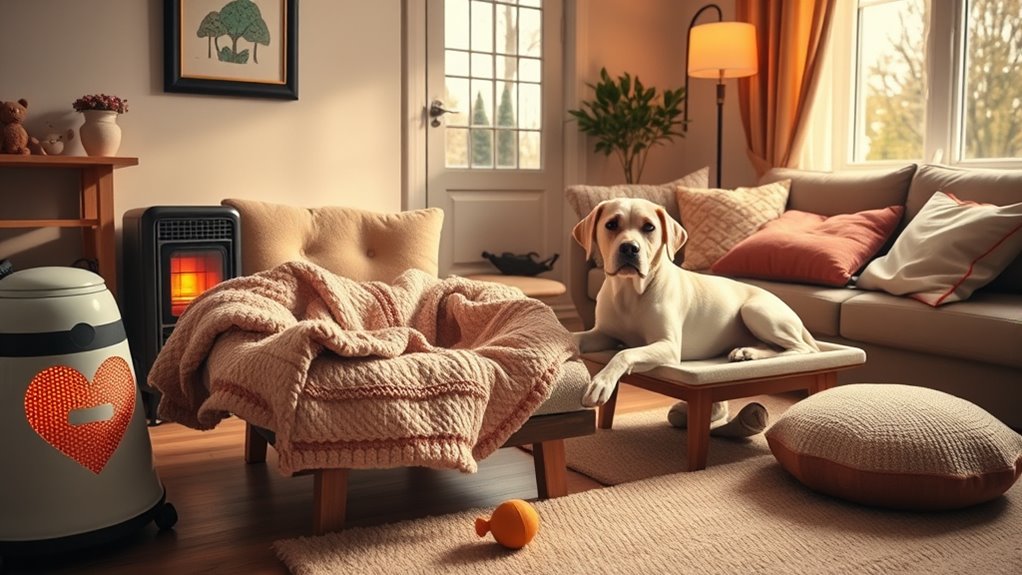
Before bringing your elderly pet indoors for the winter, it’s essential to evaluate their specific needs and comfort preferences. Every pet has unique pet preferences, which influence how they feel safe and comfortable in indoor spaces. Consider their usual routine, favorite resting spots, and activity levels. Also, factor in health considerations like mobility issues, arthritis, or sensory sensitivities. If your pet prefers certain textures or temperatures, accommodate these to reduce stress. Observe their behavior to identify what makes them most comfortable, whether that’s a cozy blanket, a quiet corner, or a specific spot near a heat source. Additionally, understanding data privacy concerns can help you safeguard your pet’s health information and ensure their environment remains secure. By understanding their pet preferences and health considerations, you create an environment that supports their well-being and helps ease the *changeover*. Paying attention to environmental enrichment can further enhance their comfort during this transition. Incorporating appropriate bedding and temperature control can also help meet their specific comfort needs and prevent issues related to cold sensitivity. Recognizing the importance of trust and emotional bonds can help reassure your pet and reduce anxiety during this period. Furthermore, selecting the right dog names that resonate with their personality can also foster a sense of familiarity and security in their new environment.
Creating a Warm and Cozy Sleeping Area
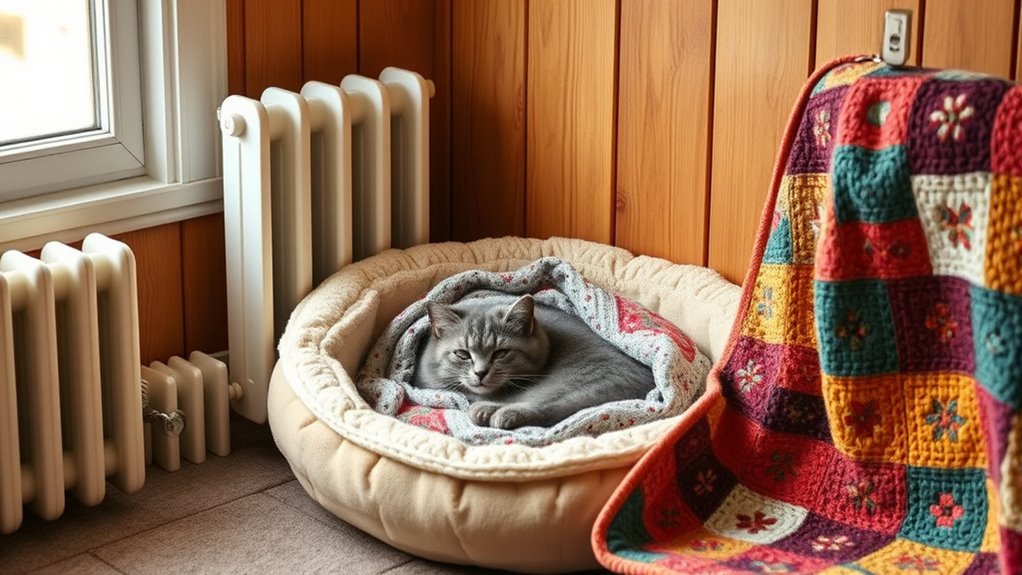
Once you’ve assessed your pet’s needs and comfort preferences, focusing on their sleeping space helps make certain they stay warm and secure. To create a cozy environment, select the right pet blanket choices that provide warmth without overheating. Consider layering blankets or choosing plush, insulating fabrics. Designing a cozy corner can also make your pet feel safe; use soft cushions, raised edges, or enclosed spaces to enhance comfort. Arrange these elements in a quiet, draft-free spot away from busy areas. Here’s a quick guide:
| Cozy Corner Design | Pet Blanket Choices |
|---|---|
| Enclosed beds or caves | Fleece or memory foam-lined blankets |
| Elevated platforms with soft bedding | Warm, snug, and easy-to-clean blankets |
| Corner nook with curtains | Thermal or plush fabrics for extra warmth |
| Soft cushions with blankets | Multiple layers for adjustable comfort |
Creating a warm, inviting space keeps your elderly pet comfortable during cold days. Understanding thermal insulation in fabrics can help you select the best materials for a cozy and effective sleeping area. Proper ventilation is also essential to prevent overheating and ensure good air circulation inside the space, contributing to your pet’s overall well-being. Additionally, providing proper airflow can help maintain a healthy environment and prevent respiratory issues.
Ensuring Easy Access to Food, Water, and Bathroom Spots
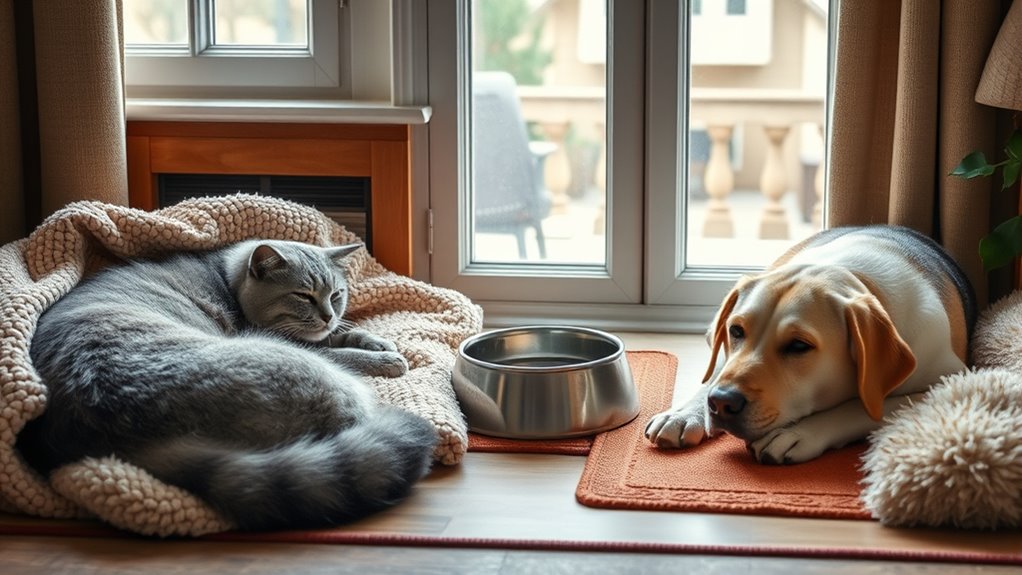
As temperatures drop, making sure your elderly pet can easily access food, water, and bathroom spots becomes essential for their well-being. Keep their food and water bowls on low, stable surfaces to prevent strain. If your pet has an outdoor shelter, ensure it’s insulated and accessible, so they don’t have to venture far outside in cold weather. Consider providing winter clothing, like a cozy sweater or jacket, to help them stay warm when they move between indoor and outdoor spaces. Regularly check that their bathroom spots are clean and easy to reach, avoiding slippery surfaces that could cause falls. Clear pathways and add non-slip mats if needed. Additionally, using appropriate equipment designed for pet safety can help prevent accidents and keep your pet comfortable during chilly days. Being aware of indoor environmental factors such as temperature and humidity levels can also contribute to your pet’s overall comfort and health during colder months. These simple steps will help your pet stay comfortable, healthy, and safe during the colder months.
Maintaining a Consistent Indoor Temperature
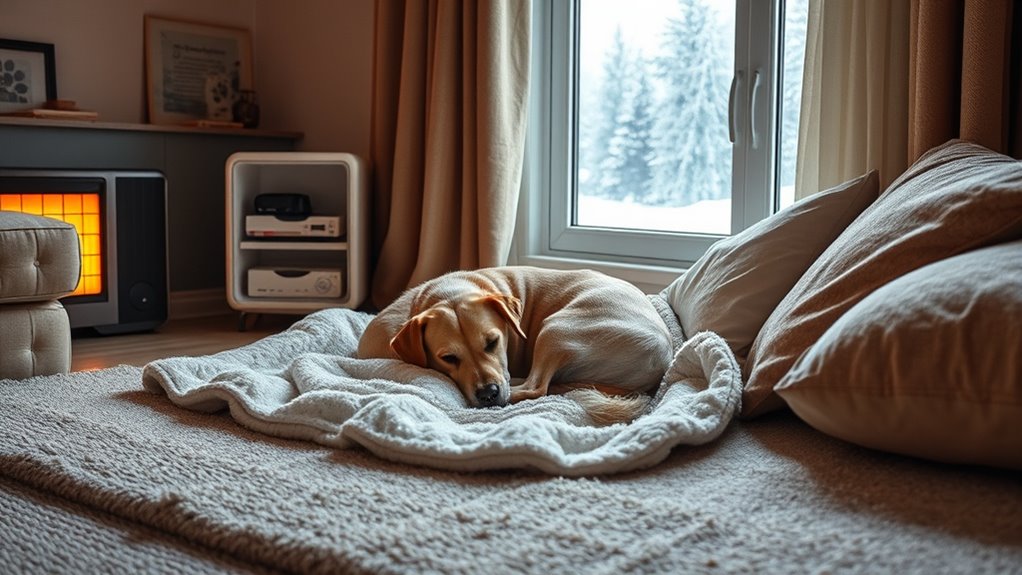
Maintaining a consistent indoor temperature is essential to keeping your elderly pet comfortable and healthy during colder months. Use pet thermometers to monitor room temperature regularly, ensuring it stays between 65-75°F. Avoid sudden temperature fluctuations that can stress your pet. Temperature-sensitive bedding helps regulate comfort, providing warmth without overheating. Keep a table nearby to track daily temperatures and bedding adjustments:
| Day | Room Temp | Bedding Comfort Level | Notes |
|---|---|---|---|
| 1 | 68°F | Comfortable | No changes needed |
| 2 | 66°F | Slightly cool | Add a blanket |
| 3 | 70°F | Perfect | Maintain current setup |
| 4 | 64°F | Too cold | Increase heating |
| 5 | 69°F | Comfortable | Monitor regularly |
Additionally, consider using heating pads designed for pets to provide consistent warmth during especially cold nights. This approach keeps your pet cozy and healthy all winter long. Regularly checking for temperature fluctuations can help prevent health issues related to sudden changes in environment. Being aware of indoor climate control techniques can further enhance your pet’s comfort. Proper ventilation is also crucial to prevent dampness and maintain air quality, which supports your pet’s respiratory health. Ensuring a stable environment is also vital for elderly pets’ well-being and can help prevent health issues related to temperature fluctuations.
Adding Extra Padding and Support to Bedding
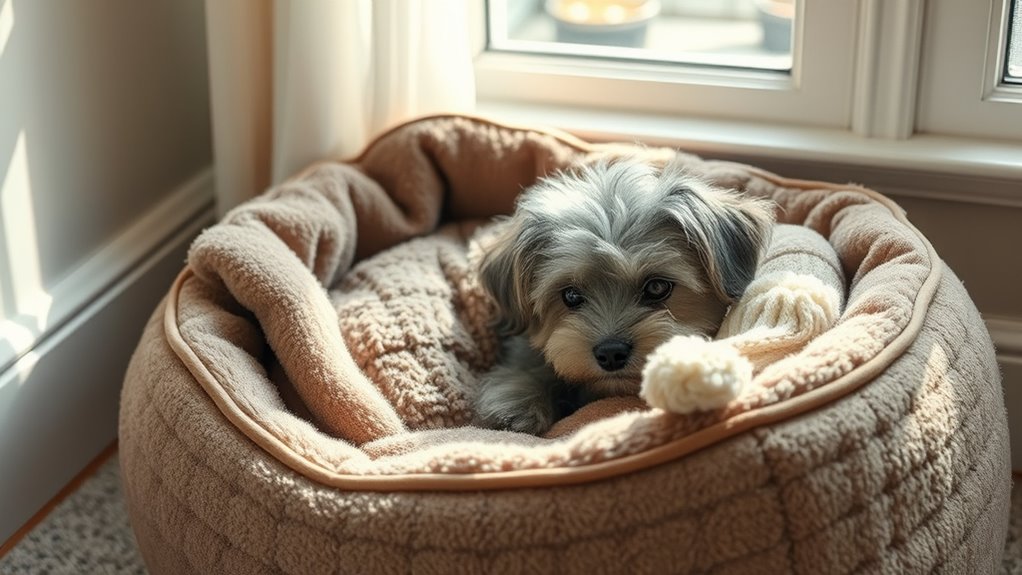
Adding extra padding and support to your pet’s bedding can substantially enhance their comfort and safety during colder months. Use cushioning materials like memory foam, thick blankets, or specialized pet bedding inserts to create a softer, more supportive surface. Supportive bedding helps elderly pets maintain proper joint alignment and reduces pressure points, which is especially important as they age. Make certain the padding is evenly distributed and fits securely within the bed to prevent shifting. You might also consider elevating the bedding slightly off cold floors or placing it in a draft-free corner. Ensuring the bedding materials are safe and non-toxic is crucial to prevent any health issues. These simple adjustments can make a significant difference in keeping your pet warm, comfortable, and well-supported throughout the winter season.
Securing Safe and Accessible Entry Points

Ensuring your pet can safely and easily access their resting area is essential as temperatures drop. Check door thresholds to make sure they are smooth and secure, preventing tripping hazards or gaps that could cause slips. If thresholds are uneven or high, consider installing ramps or low-profile thresholds to make entry easier. For homes with stairs, stair ramps are a great solution, providing a gentle incline that reduces strain on aging joints. Make sure ramps have non-slip surfaces to prevent falls. Keep pathways clear of clutter and secure loose rugs that could cause slipping. By improving entry points, you help your elderly pet move freely and comfortably, reducing stress and preventing injuries during the colder months. Incorporating installation safety strategies can also help create a more accessible environment for your pet. Additionally, consulting pet-friendly design guidelines can ensure your modifications meet safety standards and enhance overall accessibility. Properly assessing accessibility features can further improve safety and comfort for your aging pets, especially when considering home modifications to support mobility and safety.
Providing Supplemental Heating Options Safely

When choosing supplemental heating options, make certain you select devices designed for safe indoor use. Keep an eye on temperatures to prevent your pet from overheating or getting burned. Regularly monitor the heat source to ensure it stays at a comfortable and safe level for your elderly pet. Additionally, consider utilizing safety features like automatic shutoff mechanisms to reduce risks.
Safe Heating Devices
To keep your elderly pets warm and safe during colder months, choosing the right supplemental heating devices is essential. Focus on heating safety and temperature control to prevent accidents. Use heaters with automatic shut-off features and tip-over protection. Always select devices designed for indoor use, and place them on stable, non-flammable surfaces. Keep pets at a safe distance from heat sources to prevent burns. Consider options like:
- Ceramic space heaters with adjustable thermostats
- Infrared heaters that provide consistent warmth
- Heated pet mats with temperature controls
- Oil-filled radiators for steady heat
- Electric blankets designed for pets
Ensure you regularly check the temperature settings and never leave devices unattended. Proper selection and vigilant use help create a cozy, safe environment for your elderly pets.
Avoid Overheating Risks
While supplemental heating can keep your elderly pets comfortable, overdoing it can pose serious risks of overheating. Excessive heat increases overheating dangers and disrupts proper temperature regulation, which elderly pets struggle to manage. To prevent this, choose heating devices designed for pet safety, such as thermostatically controlled heaters, and set them to moderate temperatures. Avoid placing heaters too close or leaving them unattended, as this can lead to hot spots or burns. Regularly check your pet’s environment to ensure it’s warm but not excessively hot. Remember, the goal is to create a cozy space without risking overheating. Proper temperature regulation is essential for your pet’s health and comfort during cold weather. Stay attentive to avoid the dangers associated with excessive heat.
Proper Temperature Monitoring
Proper temperature monitoring is crucial to guarantee your elderly pet stays safe and comfortable when using supplemental heating. You need to regularly check the ambient temperature, ensuring it’s warm enough without risking overheating. Use a reliable thermometer and consider humidity control to prevent dry air that can irritate your pet’s skin and respiratory system. Good ventilation quality is essential to prevent stale air buildup and maintain fresh airflow. To create a safe environment, envision this setup:
- Thermometers placed at pet level to monitor real-time temperature
- Humidifiers or dehumidifiers for ideal humidity control
- Adequate ventilation to prevent stuffiness
- Spot checks during different times of the day
- Avoiding direct contact with heat sources to prevent burns
This approach helps keep your pet cozy, safe, and healthy during colder months.
Keeping Hazardous Items Out of Reach

Since elderly pets are more prone to accidents, it’s essential to keep hazardous substances and choking hazards out of their reach. Store cleaning products, medications, and chemicals in locked cabinets or high shelves, ensuring they’re inaccessible. Small items like rubber bands, strings, or coins pose choking risks and should be kept away from your pet’s area. Avoid leaving food scraps, bones, or anything sharp that could cause injury. Regularly check your space for items that might have fallen or been left unattended. By proactively removing these hazards, you reduce the chances of ingestion or injury and create a safer environment for your aging pet, especially during colder months when they may be more vulnerable.
Monitoring for Signs of Cold-Related Discomfort or Illness
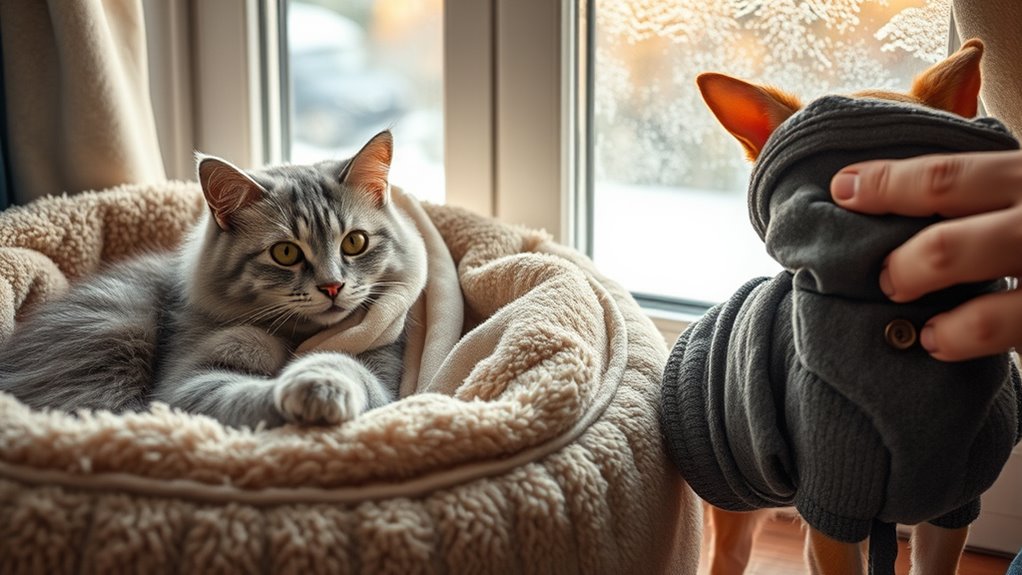
As temperatures drop, it is crucial to watch for signs that your elderly pet is uncomfortable or developing cold-related health issues. Cold weather can cause discomfort or even frostbite if left unchecked. Keep an eye out for:
- Shivering or trembling
- Lethargy or reluctance to move
- Cold ears, nose, or paws
- Whining or vocalizing in discomfort
- Pale or bluish skin, indicating poor circulation
These signs may indicate your pet is struggling with the cold or at risk for frostbite prevention issues. Regularly check their extremities and overall behavior. If you notice any of these signs, warm them gently and consider providing additional indoor insulation. Prompt action helps prevent cold-related illnesses and keeps your elderly pet comfortable and safe during winter.
Frequently Asked Questions
How Can I Tell if My Pet Is Too Cold Indoors?
You can tell if your pet is too cold indoors by paying attention to signs like shivering detection and changes in behavior. Use temperature monitoring to make sure the room stays warm enough, ideally between 75-80°F for elderly pets. Watch for signs such as curling up excessively, seeking warmth, or reluctance to move. If you notice these, increase the temperature and provide cozy blankets to keep your pet comfortable.
What Are Safe DIY Heating Solutions for Pets?
Think of DIY heating solutions as your pet’s cozy castle—crafted with love and safe materials. You can use heated blankets, space heaters, or create a warm nook with a thermal pad. Always prioritize safe DIY heating by avoiding exposed wires or unsafe materials. Use pet-safe, non-toxic insulators, and never leave heating devices unattended. Your goal: keep your elderly pet warm and secure with simple, safe solutions that mimic a gentle, reassuring hug.
How Often Should I Check My Elderly Pet During Cold Weather?
You should check your elderly pet frequently during cold weather, ideally every 2-3 hours, to guarantee their comfort and safety. Use pet temperature monitoring tools to track their body temperature and make adjustments to your indoor heating schedules as needed. Keep an eye on signs of cold stress, such as shivering or lethargy, and provide extra warmth if necessary. Regular checks help prevent hypothermia and keep your pet cozy.
Are There Specific Materials Best for Elderly Pet Bedding?
When choosing pet bed fabrics, prioritize soft, cozy materials like fleece or plush to keep your aging pet warm and comfortable. Insulating materials such as memory foam or thermal pads provide extra warmth and support, especially in colder months. Avoid thin or rough fabrics that can cause discomfort. By selecting the right insulating materials and soft fabrics, you guarantee your elderly pet stays warm, secure, and happy indoors.
How Can I Prevent Drafts in Pet Resting Areas?
To prevent drafts in pet resting areas, you should seal any gaps around windows and doors with weather stripping or draft stoppers. Use heavy curtains or blankets over windows during colder months, and place pet beds away from direct drafts like vents or open windows. Ensuring draft prevention keeps your elderly pet warm and comfortable, reducing stress and health risks associated with cold air exposure.
Conclusion
As frost blankets the world outside, picture your cozy home as a warm sanctuary for your elderly pet. With soft blankets, gentle heating, and safe spaces to rest, you create a haven where they can curl up peacefully, feeling loved and protected. By paying attention to their needs and keeping danger at bay, you’ll guarantee they stay comfy and happy all winter long, turning your home into their safe, warm retreat from the cold.

